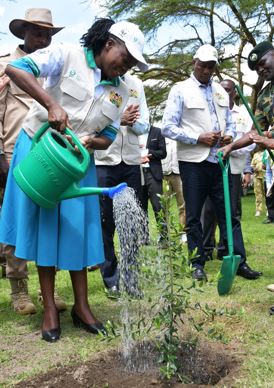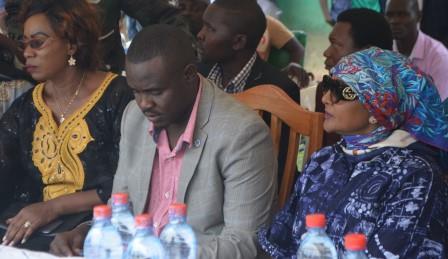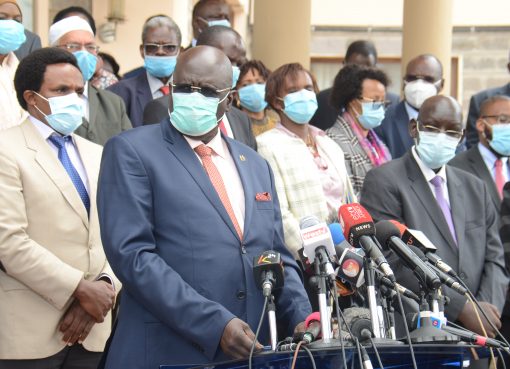The government has launched a three-year Lake Naivasha basin ecosystem management project aimed at saving the lake from extinction.
Environment, Climate Change and Forestry Cabinet Secretary (CS) Dr. Deborah Barasa, speaking in Naivasha while launching the project, said the Lake Naivasha basin is a very key natural resource to flora and fauna in the region, thus supporting livelihoods through agriculture in the highlands of Aberdares, as well as tourism and fishing in Lake Naivasha.
However, Barasa regretted the Lake basin was currently facing numerous environmental challenges, which if not addressed, could lead to devastating effects to the flora and fauna and livelihoods of many people.
The CS noted that the basin, which starts in the highlands of the Aberdares and the downstream in Lake Naivasha, provides rich agricultural lands, which supports agricultural activities.
However, she said, the basin faces numerous challenges, mostly driven by unsustainable and uncontrolled use of agricultural lands, chemicals from farmlands, effluents from the hotel industry and some instances of encroachment on riparian areas.
“If this trend continues, we shall soon lose the very important ecosystem services that thousands of people overly depend on,” she said.
To this end, Dr. Barasa stated that timely and prudent implementation of the project will deliver key outcomes, including improved basin governance, restored forest and wetland ecosystems, sustainable land management and improved ecosystem services such as an increase in fish production.
Lake Naivasha is a designated Ramsar site, meaning it’s a wetland of international importance and home to diverse wildlife, including hippos, flamingos, over 400 bird species and an active fishing community.
It also serves as a key tourism destination and plays host to global events such as the World Rally Championship (WRC), but this national pearl is under threat from degradation, pollution and loss of biodiversity.
Nonetheless, on a positive note, the project to restore the Lake Naivasha ecosystem through the National Environment Trust Fund (NETFUND) has secured an impressive $1.78 million, approximately Sh230.85 million from the Global Environment Facility (GEF), which is expected to go a long way in restoring this ecology.
The Fund will go directly towards the restoration of forest ecosystems and the reduction of land degradation within the Lake Naivasha Basin.
Thus, this initiative, named the Lake Naivasha Basin Ecosystem-Based Management Project, is a comprehensive three-year programme focused on restoring catchment and riparian lands in key zones across the basin.
Dr. Barasa called for concerted efforts from all stakeholders in conserving this ecosystem and observed that sustainable management of Lake Naivasha Basin Ecosystem requires cooperation, support and contribution from all levels of government, the private sector, non-governmental organizations and local communities who are the stewards of these landscapes.
“The initiative aligns well with key government priorities, including my ministry’s strategic focus areas on biodiversity conservation, environmental and forest restoration, and climate change action,” she stated.
The CS expressed her gratitude to the Global Environment Facility (GEF) for funding the project and the Worldwide Fund for Nature (WWF), a conservation body, for their support and the National Environment Trust Fund (NETFUND) which is a lead agency in this project.
On his part, NETFUND Chief Executive Officer Samson Toniok said the project will see the protection of key forests in Nyandarua County including 6, 600 hectares in South Kinangop, 6,800hectares in North Kinangop and 22,000 hectares that form Geta forest in the same county.
This, Tonjok added, will help address the challenges facing the lake, such as increased pollution, degradation of the lake and catchment ecosystems, encroachment of riparian land, deforestation, waste management and human-wildlife conflicts.
He however called for more funding to unlock solutions to major challenges facing the lake including degradation of catchment areas, especially at the upper areas that have in the past driven erosion and soil siltation in the lake.
Nakuru Deputy Governor David Kones, on his part, reaffirmed Nakuru county government’s commitment to environmental conservation, having enacted the Nakuru Climate Change Act of 2021, becoming one of the first counties in Kenya to legislate climate action.
He said the Act provides a legal framework that mandates the allocation of a minimum of one percent of the county’s development budget towards climate change mitigation and building community resilience and urged communities, community-based organizations, and all local actors to embrace the opportunities available through this legal framework.
Kones hailed the -The Lake Naivasha basin ecosystem management project saying it will support the development and implementation of a basin-wide management plan, ensuring that resources are not only mobilized but also used effectively and transparently and restore the lake’s catchment areas and riparian zones, addressing these challenges head-on with science-based, inclusive solutions.
“Its overarching goal is to enhance the protection of water resources, biodiversity, and the ecosystem services that are the backbone of both local livelihoods and the national economy,” he said, and voiced concern over the rising water levels in Lake Naivasha which he said have threatened both livelihoods and biodiversity.
Nyandarua Governor; Kiarie Badilisha on his part said Nyandarua County is committed to ensuring the project success by protecting key water resources and water catchment areas in the county and termed the project as a timely intervention towards environment rejuvenation, economic renewal and social inclusion.
He added that the project will address pollution and climate change causes within Nyandarua and Nakuru Counties and noting the county is committed to ensuring integration of proper and sustainable land use practices, access to climate finance and restoration resources both for women and youths.
The governor added they were also out to ensure market access for sustainable agriculture to promote sustainable farming practices and forest and riparian land restoration through rehabilitation of degraded forests and riparian ecosystems.
He said the county has in the past enacted Forests restoration strategy (2021 – 2030), a bold strategy to protect biodiversity by promoting and supporting community led restoration actions and the Climate Led Actions (2024 – 2027) which supports climate smart agriculture among farmers in the county.
Lake Naivasha, one of the freshwater lakes in Rift Valley, has a surface area of 139 square kilometres and a depth of six meters and is also home to an extensive variety of wildlife.
The lake is fed by the Malewa and Gilgil rivers and is surrounded by rich agricultural land and a network of important wetlands and forests.
Lake Naivasha has been one of the water bodies supporting the Fisheries sector in the country. The freshwater lake has for years been supporting thousands of families who depend on its resources while contributing to the economic development of the lakeside town.
Only five species of fish are present at the lake, all of which have been introduced. They include Oreochromis leucostictus, Tilapia zillii, Micropterus salmoides (largemouth bass), Barbus amphigramma and Poecilia reticulata (guppy).
By Mabel Keya-Shikuku and Erastus Gichohi




